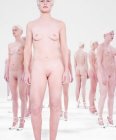The current user interface of SL turns it into a Malibu-land of Kens and Barbies. The first thing I am confronted with is the choice of two gender types, either female or male, and I have to choose one in order to proceed, and a list of starting looks which reenforce the female/male binary. Instead of pushing this binary to its polar extreme, why not build on the progress that has been made in gender studies over the past half century?
Why not have the default starting gender to be intersex, to be both female and male. Afterwards participants can change to one gender or the other, or varying degrees of both, and later, change again. This can be presented as an empowerment. Present a society where to be intersex is normative, and perceived to be positive instead of negative. Reenforce desired behavior. Online social spaces already do this effectively by putting in place structures of reward -- awarding points or listing messages such as compliments in each participant's profile. Make it hip to have looks and behaviors that are creative and original expressions against the binary female/male looks. This is not difficult to do especially if presented well: in FL we already tend to adopt the goals of people around us.
Because intersex is the starting gender, it will predominate, in the way that female and male predominate now. Doing so will not only put the issue of gender on the table, but interestingly, at the same time, explore subjectivity when biological gender is no longer a factor.
Just as in a fiction, SL can put participants into a society and culture where participants have to figure out what is going on and how things work, and in so doing, experience new ways of seeing, understanding, and interacting. "Since all of us as children are in this situation," Ursula Le Guin said, "it is a relatively interesting and relevant one." She explored the idea of an intersex society in The Left Hand of Darkness. The characters are sequentially intersex: for 24 days out of 26 of the lunar cycle, they are sexually latent, and for the remaining 2 days are female or male.
Gender identity would also be a good area for collaborative research and knowledge generation in SL, to have people discuss and share their observations and analysis.
Tony De Lucci's SL project
"Tony De Lucci’s project will explore the roles of gendered identities. The current proposal includes producing an appropriation of Vanessa Beecroft’s performance VB46 in Second Life. The installation, however, would celebrate differences in gendered identities made possible through the use of alternative avatars. The viewer would log on as a ‘gender neutral’ avatar to explore the performance installation on line. Users in Second Life would similarly be able to view and engage with the performance." (Proposal for Diego Gallery compiled by Krista Lynes)
 Image: www.homines.com/arte_xx/vanessa_beecroft/vb46_01.jpg
Image: www.homines.com/arte_xx/vanessa_beecroft/vb46_01.jpgTony has a blog Third Gender - Second Life describing his experiences in SL creating this performance. Below are several images from his photo-journal.


Images: Links to 3rdgender2ndlife.blogspot.com
Related readings:
Julia Steinmetz et al, "Behind Enemy Lines: Toxic Titties Infiltrate Vanessa Beecroft," Journal of Women in Culture & Society 31:3. University of Chicago Press, 2006.
Therese Gelais, "Vanessa Beecroft: In Search of Lost Bodies, or, On the Mechanics of Bodies" Parachute 112. HighBeam Research, 2003.
No comments:
Post a Comment